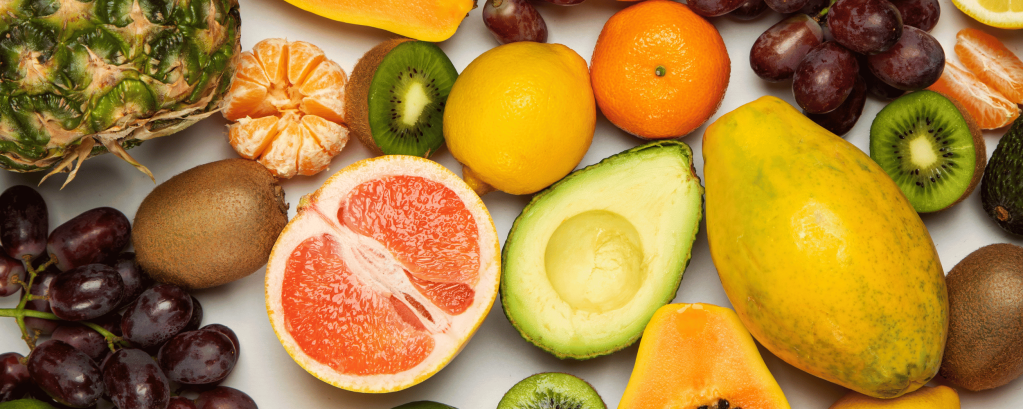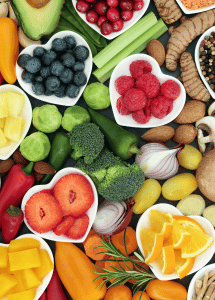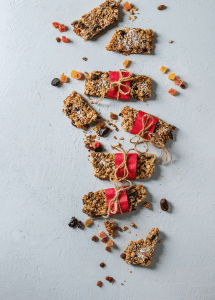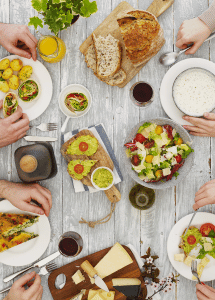EQ Nutrition Primer

 In the midst of our fast-paced lives, it’s easy to overlook the profound impact that nutrition holds on our overall well-being. The food we consume isn’t merely a source of energy; it’s the fuel that powers every aspect of our lives. Even so, according to recent studies, approximately only 1 in 10 adults meet the recommended daily amount for fruit and vegetable intake. In this Nutrition Primer, we’ll dive into why nutrition is important and share essential tips and tricks to help you make informed dietary choices for a healthier and happier you.
In the midst of our fast-paced lives, it’s easy to overlook the profound impact that nutrition holds on our overall well-being. The food we consume isn’t merely a source of energy; it’s the fuel that powers every aspect of our lives. Even so, according to recent studies, approximately only 1 in 10 adults meet the recommended daily amount for fruit and vegetable intake. In this Nutrition Primer, we’ll dive into why nutrition is important and share essential tips and tricks to help you make informed dietary choices for a healthier and happier you.
Step 1: Assess Where You Currently Are With Nutrition
Take our Nutrition Quiz to establish a baseline and understand where you are at with your overall nutrition.
Step 2: Learn and Implement: How to Build A Solid Nutritional Foundation
While some of us may have already begun to recognize gaps in our nutritional intake, making the decision to improve our overall nutrition can seem daunting without first understanding why it’s so essential to prioritize getting adequate nutrition in the first place.
Nourish to Flourish: Why Nutrition Matters
A balanced diet is the cornerstone of good health. Good nutrition works to support your body’s most crucial processes, including energy production, cell growth and repair, immune system function, digestive health, and heart health. On the other hand, when the body receives prolonged inadequate nutrition, it can lead to a range of health issues and complications.
Crafting Culinary Harmony: How to Build a Balanced Meal
Building a balanced meal is crucial for proper nutrition because it ensures that your body receives a wide range of essential nutrients in the right proportions. Here are some foods you can embrace in order to build a solid nutritional foundation and create a well-balanced meal:
- Whole Foods: The foundation of a nourishing diet is whole, unprocessed foods. These gems are rich in essential nutrients, fiber, and antioxidants. Incorporate a rainbow of fruits, vegetables, whole grains, lean proteins, and healthy fats into your meals.
- Omega-3 Fatty Acids: Omega-3 fatty acids, found in fatty fish (like salmon, mackerel, and sardines), flaxseeds, walnuts, and chia seeds are essential for brain health and cognitive function.
- Antioxidants: Antioxidant-rich foods like berries (blueberries, strawberries), dark leafy greens (spinach, kale), and colorful vegetables (red bell peppers, carrots) help protect brain cells from oxidative stress.
- Healthy Fats: Include sources of healthy fats like avocados, olive oil, and nuts. These fats support brain cell structure and communication.
- Protein Power: Include a variety of protein sources such as lean meats, poultry, fish, legumes, nuts, and seeds. Protein supports muscle health, boosts metabolism, and keeps you feeling full. You can do a deep dive into recommended protein sources as well as calculate the minimum amount of protein you should be eating here.
- Smart Carbs: Opt for complex carbohydrates like whole grains (brown rice, quinoa, whole wheat), which provide sustained energy and promote digestive health.
Ready for an exciting start on your path to improved nutrition? Try the Rainbow Challenge:
 Challenge yourself to create a breakfast, lunch, or dinner that mimics the rainbow by including a variety of colorful fruits, vegetables, and other nutritious foods in each of those meals. Different colors often indicate different nutrients, so a plate filled with a rainbow of hues ensures you’re getting a wide range of vitamins and minerals. Make it a goal to try this with at least one meal each day for the whole week and if you succeed, treat yourself to something special!
Challenge yourself to create a breakfast, lunch, or dinner that mimics the rainbow by including a variety of colorful fruits, vegetables, and other nutritious foods in each of those meals. Different colors often indicate different nutrients, so a plate filled with a rainbow of hues ensures you’re getting a wide range of vitamins and minerals. Make it a goal to try this with at least one meal each day for the whole week and if you succeed, treat yourself to something special!
Step 3: Plan Your Meals in Advance
Life’s hectic pace often leaves us scrambling for convenient food choices, which can lead to unhealthy eating habits. Enter meal planning – a game-changing strategy that not only simplifies your daily routine but also paves the way for improved nutrition and overall well-being. Here are a few tips and tricks to dominate your meal planning:
- Set Aside Dedicated Time: Designate a specific time each week to plan your meals. Treat it as a non-negotiable appointment with yourself.
- Assess Your Schedule: Consider your weekly commitments – work, appointments, and social events – to determine how many meals you need to prepare and how many days you’ll dine out.
- Start Simple: If you’re new to meal planning, begin with just a few days. Gradually expand to a full week as you become more comfortable with the process.
- Explore New Recipes: Meal planning is an excellent opportunity to experiment with new recipes. Include a mix of familiar favorites and exciting new dishes. You can check out some great budget-friendly recipes for meal prepping here.
- Prep Ingredients in Advance: After planning your meals, spend some time chopping vegetables, marinating proteins, and pre-cooking grains. This will save precious minutes during busy weeknights.
- Shop with a List: Stick to your meal plan by creating a detailed grocery list. This minimizes impulse purchases and ensures you have everything you need before you go. AnyList is a great app you can use to organize your grocery list – they make it easy to cross off and add items, and you can even reorder the categories to match your grocery store’s layout.
Step 4: Explore and Create Snacks with Purpose
Snacking can either be a mindless munching habit or a conscious choice to fuel your body with nutrients between meals. With a little planning and creativity, you can turn snacking into a healthful and enjoyable part of your daily routine. Here are a few tips and tricks to get you started with some healthy snacking:
Get Ready
Preparing snacks in advance can help you avoid reaching for unhealthy options when hunger strikes. Spend some time each week chopping veggies, portioning out nuts, or making healthy dips and spreads.
Balance Macronutrients
A balanced snack should contain a combination of carbohydrates, protein, and healthy fats. This combination helps keep your blood sugar stable and leaves you feeling satisfied for longer. Consider snack combos such as whole grain crackers with hummus, Greek yogurt with blueberries, or apple slices with almond butter.
Grab on the Go
When you’re on the move, pack portable snacks like trail mix, protein bars, or pre-cut veggies with a single-serving dip. These are great options and often avoid having to get something not as healthy on the go.
 If you want to get creative in the kitchen and make your own snacks, here are a few healthy options:
If you want to get creative in the kitchen and make your own snacks, here are a few healthy options:
- Homemade Veggie Chips: Make your own baked veggie chips using thinly sliced vegetables like sweet potatoes, beets, or zucchini. It’s a fun way to enjoy a crunchy snack while getting more veggies.
- Homemade Energy Bars: Create your own energy bars using oats, nuts, dried fruits, and a touch of honey. This way, you can control the ingredients and tailor them to your nutritional needs. Check out this recipe to get your first batch started!
- DIY Snack Packs: Create your own portion-controlled snack packs with a mix of nuts, seeds, dried fruits, and cheese. This provides a balanced dose of healthy fats and fiber.
Step 5: Navigating The Grocery Store with Finesse
 Grocery shopping plays a crucial role in maintaining a balanced and nutritious diet. By making thoughtful choices during your shopping trips, you can ensure that you’re providing your body with the essential nutrients it needs to thrive. Below are a few guidelines to support you on your grocery shopping journey:
Grocery shopping plays a crucial role in maintaining a balanced and nutritious diet. By making thoughtful choices during your shopping trips, you can ensure that you’re providing your body with the essential nutrients it needs to thrive. Below are a few guidelines to support you on your grocery shopping journey:
- Plan Ahead: Before heading to the grocery store, take a few moments to plan your meals for the upcoming week. This will help you create a shopping list and avoid purchasing unnecessary items.
- Create a Nutrient-Dense Shopping List: Focus on purchasing foods that are rich in essential nutrients, including fresh fruits and vegetables, lean proteins, whole grains, healthy fats, and dairy or dairy alternatives. Once you’re at the store, stick to your shopping list to avoid impulse buying less nutritious items.
- Read Food Labels: Limit and be mindful of added sugars, unhealthy fats, and artificial ingredients in processed foods. Yuka is a free mobile app that lets you scan the barcode of food and cosmetic products, instantly showing their impact on your health. It provides detailed information to help you understand the analysis of each product.
- Shop the Perimeter: In most grocery stores, fresh produce, meats, dairy, and whole grains are typically located around the perimeter. This is where you’ll find the majority of nutrient-dense options. By doing this you can avoid processed foods, which often contain added sugars, unhealthy fats, and high levels of sodium. Be sure to prioritize whole and minimally processed foods when you hit the grocery store.
- Don’t Shop Hungry: Shopping on an empty stomach can lead to making less healthy choices, so have a light meal or snack before heading to the store. This makes it easier to stick to your list, and only get the items you need.
Step 6: Savoring the Moment: The Art of Mindful Eating
In a fast-paced world where distractions abound, mindful eating offers a refreshing approach to nourishing your body and soul. Mindful eating involves tuning into your body’s cues and savoring each bite, which not only helps promote better digestion and nutrition absorption, but also helps foster a more balanced and enjoyable relationship with food. Here are a few tips to support mindful eating:
Create a calm eating environment
Set the stage for mindful eating by choosing to turn off phones, find a comfortable seat, and dim the lights if possible. This ambiance encourages you to focus solely on your meal.
Savor each bite
Rather than rushing through your meal, take the time to chew each bite thoroughly. Our gut doesn’t have teeth, so by chewing your food down to almost a paste you can help aid your digestion and cut down on bloating after meals.
 Practice gratitude
Practice gratitude
Take a moment to express gratitude for the food on your plate. Acknowledge the efforts that went into producing, preparing, and delivering the meal to your table.
Mindful eating can also be practiced alongside meditation to encourage a deep connection with the present moment and foster a profound awareness of each bite. Try out this short guided mindful eating meditation.
Step 7: Get creative with EQ’s Daily Nutri-Greens
 EQ’s Daily Nutri-Greens is a delicious, phytonutrient-packed daily powder that supports your body’s key functions and fills nutrient gaps left by your normal diet. Providing a healthy foundation for your wellness routine, our comprehensive blend of greens, fruits, prebiotics, probiotics, antioxidants, detoxifiers, and enzymes boost everyday health and nutrition by promoting digestive health, boosting immunity, supporting healthy energy levels, and helping the body flush out toxins.* This versatile powder can be stirred into water, blended in a smoothie, stirred into yogurt, or added to your favorite pancake batter. Get creative with it and try the recipes below!
EQ’s Daily Nutri-Greens is a delicious, phytonutrient-packed daily powder that supports your body’s key functions and fills nutrient gaps left by your normal diet. Providing a healthy foundation for your wellness routine, our comprehensive blend of greens, fruits, prebiotics, probiotics, antioxidants, detoxifiers, and enzymes boost everyday health and nutrition by promoting digestive health, boosting immunity, supporting healthy energy levels, and helping the body flush out toxins.* This versatile powder can be stirred into water, blended in a smoothie, stirred into yogurt, or added to your favorite pancake batter. Get creative with it and try the recipes below!
Daily Nutri-Greens Baking Recipes
Green Nut-Butter Bites
- 1 tablespoon vanilla extract
- 1 cup natural peanut butter natural almond butter recommend creamy unsweetened at room temperature
- 3/4 cup of honey or maple syrup
- 3 cups quick oats
- 2 scoops EQ Daily Nutri-Greens
- Mix nut butter, vanilla, and sweetener in a large bowl until well combined. In a separate bowl, combine all the dry ingredients and mix until the ingredients are well combined.
- Add the dry ingredients to the wet, and if it seems too dry add a 1-2 tsp of water.
- Form the dough into small balls and place the balls on a plate or cookie sheet and chill in the refrigerator until they are firm (1-3 hours).
- Put into a container, where they will keep for 4-5 days.
Easy Banana Muffins
- 4 tablespoons unsalted butter or Coconut Oil
- 1/3 cup honey or pure maple syrup
- 3 medium bananas, well-mashed
- ¼ cup milk (whichever kind you prefer)
- 1 teaspoon vanilla extract
- 2 eggs
- 1 teaspoon cinnamon
- ¼ tsp nutmeg
- 1 teaspoon baking soda
- ½ teaspoon salt
- 1 ¼ cups white whole wheat flour or gluten-free flour blend (such as Bob’s Red Mill 1:1)
- ¼ cup EQ Daily Nutri-Greens
- Optional: ½ cup mini chocolate chips or chopped walnuts

- Preheat oven to 350 F. Spray a muffin tin with cooking spray or line with paper liners.
- Melt butter or coconut oil. Add to a large mixing bowl with the honey or maple syrup, mashed banana, milk and vanilla.
- Whisk well to combine, then whisk in the eggs.
- Add the cinnamon, baking soda and salt over the wet ingredients. Whisk until well combined.
- Add the flour and greens to the bowl and stir with a spoon or spatula until just combined. Do not over-mix.
- Fold in chocolate chips or nuts if using.
- Scoop the batter into the prepared muffin tin & bake for 15-17 minutes until lightly brown on top and springy to touch.
Daily Nutri-Greens Smoothie Recipes
Tropical Dream Smoothie
- 1 scoop EQ Daily Nutri-Greens
- 1 banana
- ¼ cup frozen pineapple
- ¼ cup frozen mango
- 1 cup of milk of your choice
Add all ingredients to a blender, and blend on high until smooth.
 Very Berry Smoothie
Very Berry Smoothie
- 1 scoop Daily Nutri-Greens
- ¼ cup frozen strawberries
- ¼ cup frozen blueberries
- 1 cup of milk of your choice
Add all ingredients to a blender and blend on high until smooth.
Pineapple Smoothie
- 1 scoop EQ Daily Nutri-Greens
- 1 cup coconut water
- 1 cup pineapple
- Handful of ice
Add all ingredients to a blender, and blend on high until smooth.
The Takeaway…
Remember that achieving a healthier you isn’t about perfection; it’s about progress. Embrace the concept of small, sustainable changes that accumulate into long-lasting habits – whether you’re taking steps toward incorporating more whole foods into your diet or exploring the world of meal planning, every effort you make contributes to your well-being.
Sources:
- Lee SH, Moore LV, Park S, Harris DM, Blanck HM. Adults Meeting Fruit and Vegetable Intake Recommendations — United States, 2019. MMWR Morb Mortal Wkly Rep 2022;71:1–9. DOI: http://dx.doi.org/10.15585/mmwr.mm7101a1
- https://www.cdc.gov/nccdphp/dnpao/division-information/media-tools/adults-fruits-vegetables.html#content
- https://thewholeu.uw.edu/2020/03/02/nnm-2020-nutrition-and-the-brain/
- https://www.ncbi.nlm.nih.gov/pmc/articles/PMC7322667/
- Cena H, Calder PC. Defining a Healthy Diet: Evidence for The Role of Contemporary Dietary Patterns in Health and Disease. Nutrients. 2020;12(2):334. Published 2020 Jan 27. doi:10.3390/nu12020334
- Gómez-Pinilla F. Brain foods: the effects of nutrients on brain function. Nat Rev Neurosci. 2008;9(7):568-578. doi:10.1038/nrn2421
- https://www.apa.org/monitor/2023/06/nutrition-for-mental-health-depression